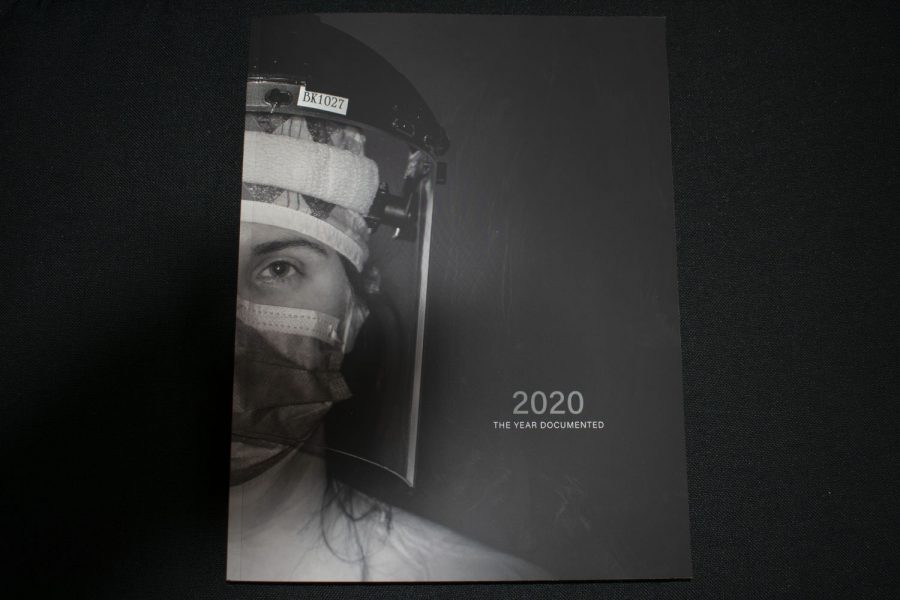Capturing a historic year: DI photobook tells the story of 2020
The Daily Iowan’s 2020 Photobook reflects the year’s lifestyle modifications, landmark events, and tragedies.
Cover of 2020: The Year Documented.
March 7, 2021
Flipping through “2020: The Year Documented,” readers see photographs featuring gatherings of masked people, Black Lives Matter protesters forced into the pavement, dilapidated homes, and vacant sports stadiums.
“2020: The Year Documented” is a photo book composed of historic moments captured throughout the year by The Daily Iowan’s photojournalists. The photo book also spotlights 25 essays from distinguished university and local leaders, as well as leading journalists from the DI.
This project is the DI’s first photo book that provides an all-encompassing review of a specific year, DI Publisher Jason Brummond said, showcasing 140 photos across 208 pages.
The staff completed most of the final photo selections, layout, design, and editing in December 2020 and January, he said.
“I’m thrilled with how it turned out. It combines the great photographic work we had from a historic year with essays from prominent University of Iowa leaders and alumni,” Brummond said. “It captures the key moments and stories from 2020, which is a year we will all be remembering and talking about.”
DI Visuals Director Katie Goodale, a UI senior, said she captured her most memorable work in the 2020 photobook at one of Iowa’s first protests following the death of George Floyd, a Minneapolis man who died after a police officer knelt on his neck for several minutes.
“We attended an event in Des Moines that was held in memory of George Floyd, and then things started to escalate,” Goodale said. “[DI staffers] Josie [Fischels] and Jenna [Galligan], who were both with me at the time, we were all like, ‘This is going to be something big.'”
Goodale seized the opportunity to take pictures during the Des Moines protest, which later earned her a first-place award from the Iowa Newspaper Association for Best Breaking News Photo.
Featured on page 88 of “2020: The Year Documented,” the award-winning photograph encapsulates the anguish and passion felt by racial justice protesters last summer.
“I had to lay on the ground right in front of the police to take the photo,” Goodale said. “It was a somewhat scary assignment. I wasn’t used to protests like the way I am now.”
Some photojournalists covered 2020 events in unusually empty settings.
UI senior and DI photojournalist Shivansh Ahuja said it is strange witnessing the contrast between photographs of pre-pandemic sporting events compared to later ones of empty stadiums.
“One of my favorite pictures from the photo book is from the wrestling meet between Iowa and Penn State back at the end of January 2020. Carver was packed — it was full of people,” Ahuja said. “It was only a month and a half before the lockdowns started.”
In another photo, he said he captured what seemed to be a different reality.
“The Michigan State football game was the exact opposite [of the wrestling meet]. There were just about 1,000 people in Kinnick,” he said. “It was just a really stark contrast. I know that they were months apart, but this was the same university with two really popular sports events with one that was completely packed, and in the same year, one was dead empty.”
The Iowa Newspaper Association recognized Ahuja’s photojournalism with awards in six different categories.
DI Projects Videographer Jenna Galligan, a University of Iowa junior, photographed the portrait featured on the cover of “2020: The Year Documented.”
While taking photos of people on the frontline, Galligan said she had the chance to learn more about her subjects than she would during a typical year.
“It’s been interesting to see the conversations that come out of this time. I think everyone’s had more time to get to know themselves, and then on top of that, are starved of that connection to share with people,” Galligan said. “I had a lot of interesting interactions with subjects this year that I don’t think that we would have under other circumstances.”
Although safety among journalists doing this kind of coverage remained a concern, Brummond said the DI has a responsibility to keep the university and Iowa City community informed.
“I think this is a really unique project that not many, if any, other college newspapers could have pulled off. We have such a talented visual staff that strives to tell stories and keep the community informed,” Brummond said. “But our job even goes beyond that. Our job is to provide a historical record of what happened on campus or in this community.”






